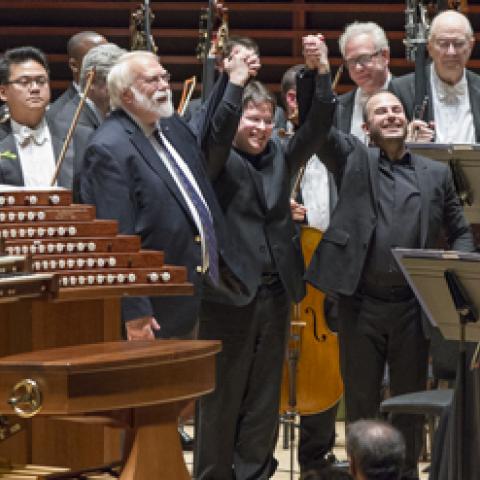Joel H. Kuznik, M.Mus., STM, had careers as a minister, college organist, professor, and business executive before retiring and becoming a music critic and author. In the past several years he has had 24 articles published in four journals, including a highly researched article on concert hall organs. He was also the lead presenter of the AGO committee for advocating the inclusion of a pipe organ in the renovation of Avery Fisher Hall at Lincoln Center, New York, scheduled to begin in 2009.

Philadelphia has joined the array of major U.S. orchestras with a concert hall organ. With the installation of the Dobson organ in the Kimmel Center for the Performing Arts, Verizon Hall became the tenth American concert hall with a new or renovated organ since Dallas in 1992. In 2004 came Los Angeles, Madison, and Boston, and still to come are San Luis Obispo, Orange County, and Nashville in 2007 with Atlanta in 2009.
The Dobson organ is impressive in its numbers: 88 registers, 111 stops, 125 ranks, and 6,938 pipes at a cost of $6.4 million with a planned $5 million to endow the organ, its programs, and education. The organ weighs 32 tons and took four semis to deliver. Three blowers totaling 25 horsepower supply the organ with wind pressures ranging from 41?2? to 20?, supported by 15 reservoirs.
The tracker-action instrument represents the latest in computer technology with an on-stage electric console and a memory system of 300 levels to control 48 combination pistons and 22 pedal pistons. The organ required 52,000 man-hours to build with an estimated additional 10,000 hours for installation and voicing.
The organ was built on a fast track. A design retainer was signed in July 1999 when the building itself was already under construction. The façade casework and the largest 32¢ pipes were installed to meet the hall’s opening in December 2001. The tracker console was installed in the summer of 2004, and the remainder of the organ was delivered in the summer of 2005. Installation was completed October 1 to allow seven months for voicing before the May 2006 inaugural Organ Festival.
The organ is one of design collaborations. The organ design involved the interaction of Lynn Dobson with the hall’s architect, Raphael Vinoly, and the acoustical engineer, Russell Johnson. Several models were built by the architect and organ builder and submitted to the organ committee for comment and approval. The organ case is constructed of American black cherry and hard maple with a stained and lacquered finish. Some of the 32¢ metal pipes made of a burnished tin alloy of 83% tin and 17% lead are in the façade arranged in a broadly curving arc, leaning out at a 4° angle, creating a parallel with the hall’s balconies.
The tonal design of the organ—its specification, pipe scaling, voicing treatments and tonal finishing were a collaborative effort between Dobson Pipe Organ Builders, Ltd. and Manuel Rosales of Los Angeles. They have collaborated previously in a project for West Market Street United Methodist Church in Greensboro, North Carolina.
For information on the organ, go to
The organ is designed to meet three criteria:
• Function as a solo instrument in recital, which requires a diversity of stops appropriate for performing the organ literature composed over the last 400 years;
• Accompany choral groups, which demand a dynamic range and stops appropriate to support singers from large and small ensembles;
• Perform orchestral literature as an ensemble instrument in small and large orchestral works.
The 2006 Organ Festival, as announced by the Kimmel Center’s Vice President for Programming and Education, Mervon Mehta, will illustrate how this organ fulfills its objectives with twenty events—beginning on May 11 with the Philadelphia Orchestra under its music director, Christoph Eschenbach, featuring Olivier Latry of Notre Dame, Paris, in three identical programs with works by Levinson, Barber, Corrette and Saint-Saëns—and concluding May 25 with the visiting Pittsburgh Symphony under Manfred Honeck with symphonies by Mozart and Tchaikovsky with Jeffrey Brillhart in Poulenc’s Concerto.
The full inaugural program, as it is developed, can be seen at



